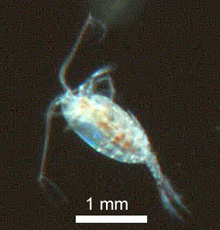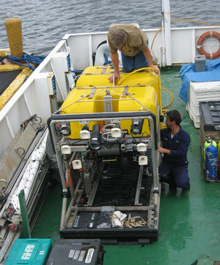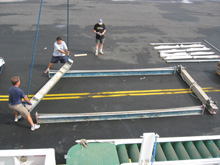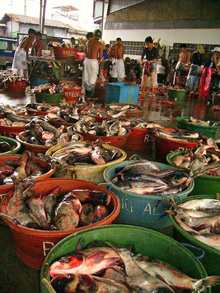Joe Caba and Toshi Mikagawa connect the Global Explorer remotely operated vehicle (ROV) to its yellow tether. The slightly buoyant, 150-foot-long tether will be attached to an 800-pound weight, suspended from the ship. Fiber optic cables inside the tether and inside the wire running from the weight up to the ship will transmit video signals and operational commands between the pilots’ control center and the ROV. Click image for larger view and image credit.
The frame of the MOC 10 trawl is bolted together on the dock next to the ship. Once the frame is assembled the white nets rolled up on the asphalt behind the frame will be attached. The mouth of each net is 10 square meters in area. With such big nets, we hope to catch rare and large animals that would not be captured in nets with smaller openings. Click image for larger view and image credit.
A Fish Called Imelda
September 30, 2007
Gwen Noda
Program Coordinator, COSEE-West
University of California, Los Angeles
It's the last day of September and we are making the final preparations for our trip. Since September 27, we have been moving, loading, unpacking, and putting together equipment on the ship, and we have gone on numerous shopping trips to finish outfitting the ship (and us) for the expedition.
The remotely operated vehicle (ROV) has required the most time to set up. In fact, Toshi, Joe, and Mike have been working seemingly nonstop for the last three days (and they are still working furiously as I write). Not only do they have to attach all the small and moving parts to the ROV frame that had been removed for shipping, they also have to assemble the control panels and connect them to each other, and to the ROV's cameras, lights, and collecting equipment, the six-ton winch, and the clump weight — and then make sure it all works!
Meanwhile, the scientists have staked out their spaces in the lab. A microscope connected to a flat panel screen, holographic digital imaging equipment, and a kreisel with a chiller (an aquarium that continuously moves water in a vertical circular motion) are just a few of the things that are now secured to countertops to prevent them from falling off and breaking when we get out in rough water.
The Zodiac that we will use to deploy the blue water divers is being assembled as I write. Yes, that's right, we brought our own inflatable boat and outboard motor. Sticking my head out the door, I can see them inflating the boat on the dock to look for holes. The next step will be to make sure the motor is ready to go as well. Before we leave dock, we also have to put together the MOC 10 trawl frame, because the 10- x 10-meter metal frame requires a lot of room, a crane, and many hands to assemble. When we leave the dock, it will take us a couple of days to get to our research site, so we will use that time to continue to assemble equipment, primarily the nets that we will use to catch plankton and fish.
Some vendors at the fish market sell "Imelda," an important local food fish. Here each bucket contains about 1.5 kilograms of whole, freshly caught Imelda. The workers (in the background) tie plastic sheets around their waists in an effort to keep clean, while they work in assembly-line fashion. The first person cuts off the fish's head, the second cuts the fillets, which then go to one person to be skinned. The bones go to yet another person, who scrapes bits of meat from the skeleton. Click image for larger view and image credit.
During the last few days we have shopped for common household items, ranging from bar soap and paper towels to an air conditioner. The first stop yesterday was at the Hyper Market in the Mall of Asia — a huge shopping mall across the street from the waterfront with its own IMAX theater. The Hyper Market is like a large, diversely stocked grocery store combined with a Target. Here we bought things like laundry detergent, wall hooks, hand towels, sponges, dried mangos, and cans of Coca-Cola. People were sure surprised (or maybe confused) when a dark blue, armored van loaned to us by the U.S. Embassy showed up, and we jumped in with our fluorescent green Hyper Market grocery bags.
Our second stop was a store called Home Depot, which turned out to be more like Expo in Los Angeles (as far as what it carried), with the ceiling height of a Costco. It sold kitchen and bathroom fixtures, sinks, tubs, toilets, saunas, ceramic tile, etc. They also had some lighting fixtures by IKHEA, which I assume is the same as IKEA in the U.S. And they also had some plywood, which is what we were there to buy. We wanted it cut to a certain size, which they willingly did, but we were worried at first that we might get a piece of wood that was 30 x 20 centimeters instead of 30 x 20 inches.
Then there was the shopping trip for 100 kilograms (kg) of fish at the fish market. Today at 6:30 am we headed to the fish market to purchase bait for the RopeCams that we will deploy during the trip. The first fish market we visited had small fish, ones that could fit in the palm of your hand, but we wanted something bigger, preferably tuna. The second market we went to definitely had larger fish and we purchased fish from two different vendors. We ended up with a bag full of fish that is locally called "Imelda," which we think is an estuarine fish called barramundi cod. We also bought a bag of fish the locals called "Tanigue" (taw-nee-ge), which is probably a wahoo. Those fish are now frozen with our food in the ship's galley.
Yesterday's weather had us a little worried. There were two low-pressure storms passing through the area. The first one passed through two days ago and dropped rain on us for only an hour or so, but the second one that passed through yesterday actually brought increased wind, choppy water in the harbor, and rained for much of the day. Although, we are anxious to get out to sea, we were quite glad to ride out that storm here at the dock.
Last night, Mon, Mely, and Hildie — three of the Filipino scientists — arrived at the ship. They joined us for dinner in the mess hall and moved into their accommodations onboard the ship.
We hope to be ready to leave the dock at 8 am tomorrow. Let the adventure begin!






























